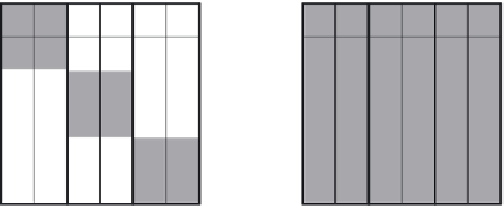Database Reference
In-Depth Information
1 23456
123456
1
2
1 10000
1
2
100000
1 10000
110001
3
4
0 01100
0 01100
3
4
001110
100100
5
6 00011
0 00011
0
5
6
001011
0
1
0 011
1
2
3
4 5
6
1
4
2
6 3
5
FIGURE 8.3
Clustered vs. nonclustered adjacency matrices for two isomorphic graphs. The
edges are grouped into 2 × 2 blocks. The left graph uses only 3 blocks, whereas the right
graph uses 9 blocks.
8.4.4
GIM-V
Di: Di:
iagonal
b
loCk
i
iteration.
Reducing the number of iterations required for executing an algorithm in MapReduce
mitigates the computational cost a lot, since the main bottleneck of
GIM-V
is its
shuffling and disk I/O steps. In Hcc, it is possible to decrease the number of itera-
tions when the graph has long chains. The main idea is to multiply diagonal matrix
blocks and corresponding vector blocks as much as possible in one iteration. This is
illustrated in Figure 8.4.
Algorithm 8.3 Renumbering the minimum node
Input:
Edge
E
= {(
id
src
,
id
dst
)},
current minimum vertex id
minid
cur
,
new minimum vertex id
minid
new
Output:
Renumbered Edge
Vidid
src
{
(
)
}
=
′
,
′
dst
1: Renumber-Map(key
k
, value
v
):
2:
src
←
k
;
3:
dst
←
v
;
4:
if
src
=
minid
cur
then
5:
src
←
minid
new
;
6:
else if
src
=
minid
new
then
7:
src
←
minid
cur
;
8:
end if
9:
if
dst
=
minid
cur
then
10:
dst
←
minid
new
;
11:
else if
dst
=
minid
new
then
12:
dst
←
minid
cur
;
13:
end if
14: Output(
src
,
dst
);
























































Search WWH ::

Custom Search